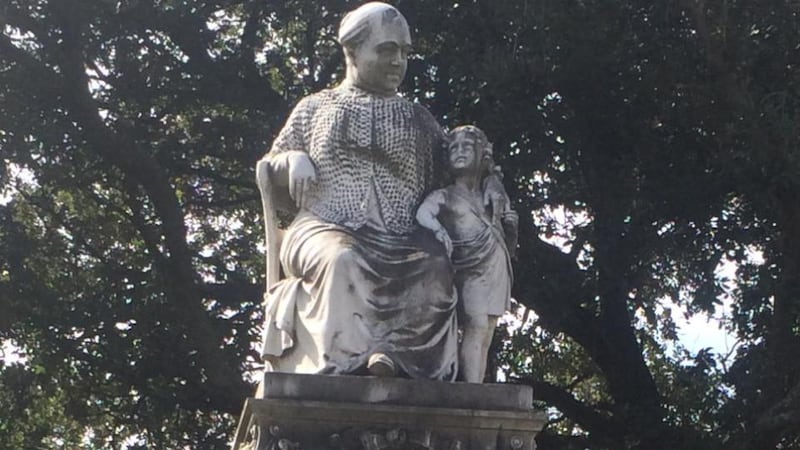Where Clio Street and Camp Street meet in New Orleans is a patch of grass that is home to a statue dedicated to one of the most remarkable Irish women of the 19th century – an emigrant and perhaps Ireland’s first leading female philanthropist and entrepreneur.
The stone figure shows a small, square-jawed woman sitting forward in a chair with her arm around a small child. The only inscription is the name "Margaret". Erected in 1884, it was the first public statue to be dedicated to a woman in the United States.
To say that Margaret Haughery overcame adversity is an understatement. From Tully South in Carrigallen, Co Leitrim, she emigrated to the US in 1818 at the age of five and by nine had lost both parents to yellow fever. Two siblings also died. By the age of 23, after moving from Baltimore to New Orleans, she had lost her husband and only child, a six-month-old daughter, Frances.

A foreigner in a strange city, then America’s fourth-largest, Haughery found work as a laundress in the St Charles Hotel and support from the Sisters of Charity. In return for helping at the order’s New Orleans Female Orphan Asylum, she was given a room to live in. Thinking the orphans should have fresh milk, she used her savings to buy two cows and sold surplus milk to neighbours. Within two years, she had 40 cows and a booming dairy that also sold cream and butter.
She kept her expenses low and profits high by running the milk cart herself, ensuring that it would go out full but never return empty as she solicited goods and donations for the orphans on the trip home.
She started using her money to lend at low rates to businesses. Among her borrowers was the D'Aquin Bakery near the Mississippi waterfront. In exchange, she received shares in the bakery. By 1859, she was the majority owner of a business facing bankruptcy.
Steam technology
Extending the bakery’s products to crackers, cakes and flour, she started supplying shipping merchants passing through New Orleans, the second-largest US port. She invented a way of packaging crackers to keep them “fresh” for shipping.
The bakery became the first in the south to operate machinery by steam and one of the biggest in the US, producing 800 barrels of flour a day beyond what it required for itself.
"She followed the basic business strategy of offering a good product for a reasonable price and, as her demand grew, rather than increasing the price, she simply expanded production," writes Dr Laura Kelley, a history lecturer at Tulane University in New Orleans and the editor and co-author of a new book, The Irish in New Orleans.
Ever the philanthropist, Haughery distributed profits among the Sisters of Mercy and other charities. To the hungry, she gave free half-loaves – halves because she knew they couldn’t sell them to buy drink.
When she died in 1882, she left the equivalent of almost $1.2 million (€1 million) to orphan asylums and other charities. Her pallbearers included Louisiana’s governor and the mayor of New Orleans. Her will was signed with an “X” – she had never learned to read or write.
"This is a woman who was remarkably charitable but who had this savviness – in charities you don't always get that but she managed to balance it very well," said Kelley, who led a tour of visitors, including Minister for the Arts Heather Humphreys, to the statue last Saturday. In a rare reference to Irish involvement in America's civil war by a Government Minister, Humphreys paid tribute on her New Orleans visit to more than 150,000 Irish soldiers who fought on the Union (north) side and the 20,000 on the Confederate (south) side.
Carrigallen cottage
Also on the tour of Haughery’s statue were
Maura Williamson
and
Helen Corcoran
, secretaries of the Margaret of New Orleans Birthplace, who travelled from Carrigallen where the Haughery family cottage has been restored.
“She had that great spirit of the Irish,” said Williamson, who has written a play about Haughery and is pushing for her beatification.
“I met a group of women here the other night – they lost everything in Hurricane Katrina and yet they had that fight and spirit to get up and get on: that is the Irish spirit and that’s Margaret’s spirit.”
Haughery’s story, much like that of the Irish in New Orleans, is a hidden history compared with the large Irish communities in the north.
The first Irish came here as the French and Spanish colonial children of the Wild Geese and, after 1778, as political exiles. During the Famine, a shipping route from Liverpool ferried the Irish directly, while the Mississippi's steamboats brought them here from across the US. By 1850, one in every five New Orleanians had an Irish accent.
“It’s important to realise the Irish didn’t just move from east to west following the railroad,” said Kelley. “The south got hit by the Irish in certain ways that weren’t predictable.”












